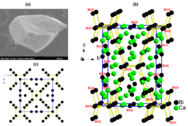
The pnictide phase Ca11Bi10−x shows bulk superconductivity around 2.2 K in temperature-dependent resistivity and magnetic susceptibility data. The compound is a p-type metal with low carrier density of 6.5 × 1018 cm−3. Ca11Bi10−x(x = 0.12) was synthesized by the reaction of Cametal with excess Bi and crystallizes in the tetragonal space group I4/mmm with a = 12.2842(6) Å and c = 17.866(4) Å. The structure of Ca11Bi10 contains three discrete units: isolated Bi atoms, dumbbells, and square planar rings of Bi surrounded by Ca atoms. Vacancies were found in the isolated Bi(1) atoms and square planar Bi4 units of the structure. The Ca11Bi10 system is the first member found to exhibit superconductivity among the intermetallic class M11X10 (M = Ca, Sr, Ba; X = Bi, Sb), suggesting that a broader family of Bi or Sb containing superconductors may exist. In fact, Ca11Sb10−x [x = 0.11(2)] also show superconductivity around 1.8 K.
Electronic structure density functional theory calculations for Ca11Bi10−x (x = 0.12) confirm the metallic nature of the compound with several steep Bi p-orbital bands crossing the Fermi level as well as a single flat band reaching the Fermi level upon the introduction of Bi vacancies.
Related Article
M. Sturza, F. Han, C. D. Malliakas, D. Y. Chung, H. Claus, M. G. Kanatzidis,
Phys. Rev. B. 2014, 89, 054512-1-6.
